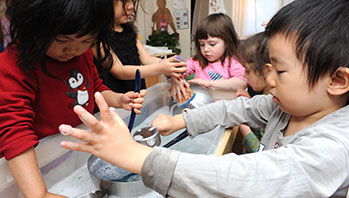- clear plastic tubing
- funnels
- large tub or water table
- pipettes or eyedroppers
- plastic cups
- soda bottles
- sponges
- squirt bottles
- toy water pumps or recycled soap dispensers
- turkey basters
- move
- pour
- pump
- squirt
- water
MA Standards:
Language/L.PK.MA.6: Use words and phrases acquired through conversations, listening to books read aloud, activities, and play.
MA Draft STE Standards:
Earth and Space Sciences/Earth’s Systems/ESS2.A: Observe, investigate, and classify the non-living materials, natural and human made, in their environment.
Head Start Outcomes:
Logic and Reasoning/Reasoning and Problem Solving: Classifies, compares, and contrasts objects, events, and experiences.
Science Knowledge/Conceptual Knowledge of Natural and Physical Worlds: Observes, describes, and discusses properties of materials and transformation of substances.
PreK Learning Guidelines:
English Language Arts/Language 2: Participate actively in discussions, listen to the ideas of others, and ask and answer relevant questions.
Science and Technology/Inquiry Skills 4: Record observations and share ideas through simple forms of representation such as drawings.
Science and Technology/Earth and Space Sciences 5: Compare and contrast natural materials such as water, rocks, soil, and living organisms using descriptive language.
Science and Technology/Physical Sciences 19: Explore, describe, and compare the properties of liquids and solids found in children's daily environment.
Explore Together (indoors): Water Tools: Introduce Tubing

© Commonwealth of Massachusetts, Department of Early Education and Care (Jennifer Waddell photographer). All rights reserved.
STEM Key Concepts: You can use different objects to move water
ELA Focus Skills: Listening and Speaking, Vocabulary
Educator Prep: For this activity, set up a water table or tub of water for children to use to explore. You may want to set up a water table outside as well. Cover the floor with plastic. Put newspapers or towels on top. Provide water smocks (garbage bags with holes for head and arms work well). Set guidelines about splashing and squirting.
Invite children to continue exploring moving water using the water tools they used in Week 1. This week, add plastic tubing to the set of materials that children can use to make water move.
Show children the tubing. Talk about what the tubing is, and ask children to think about how they might use it to move water. Let children freely explore using the tools. As they explore, ask questions to keep their explorations going, such as,
- How are you using the tube to move water?
- How does the water move through the tube?
- Can you use the tube to carry water? How?
- How did you put the tube and the funnel together?
Encourage children to combine tools to move water from one place to another. Suggest challenges or problems for children to solve. For example, ask, How can we get water from one place to another using the sponge? What’s the best way to move water from the funnel to the bottle? Let children work together to come up with solutions.
Take photographs and/or video children as they explore. Invite them to draw pictures of the tools they used and how the water moved when they used the tools. Ask children to dictate or write any sound words to describe the sounds of the water as it moved through the tools.
Reflect and Share
Allow plenty of time to explore with the water tools. Once you gather children, have them demonstrate the ways they used the tools to move the water. Discuss any photographs you took and/or any video recordings. Have children present and share their drawings.
Adaptation: You may want to set up more than one table. Younger children may want to simply continue exploring moving water with their hands, and not be interested in exploring the tools yet.
Adaptation: If the weather is warm, wheel your water table(s) outside or fill a plastic pool with water. Then help children do the activities outdoors, where they can explore without worrying about spills.
